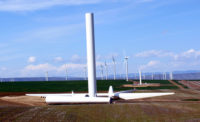Hot on the heels of the startup of Nevada's first wind power project on public land, the forecast for the nation's wind industry is beginning to turn, well, not so swell. Sector layoffs and plant shutdowns this year are up and are expected to continue next year, which many industry players largely blame on the scheduled expiration of the renewable energy production tax credit (PTC) by year-end.

Even so, this has been a strong year for U.S. wind-power capacity increases, with total capacity expected to soon pass the 50-GW mark, according to the American Wind Energy Association (AWEA), Washington.
New projects in the Southwest include Nevada's first wind project on public lands—Pattern Energy Group's 151.8-MW Spring Valley wind farm, near Ely, which was completed Aug. 8. Mortenson Construction was the general contractor on the project, which uses 2.3-MW turbines and is connected to an existing 230-kilovolt transmission line for electricity distribution. Owner Pattern Energy was the engineer.
One of the project's big supporters, U.S. Sen. Harry Reid (D-Nev.), praised Pattern for working with state and federal agencies as well as with White Pine County on the project. "We have just begun to tap into Nevada’s tremendous wind energy resources and more job-creating projects like this will be good for our economy and our environment," he says. Reid is also a proponent of extending the PTC for wind power.
Such enthusiasm for wind projects in recent years helped make first-quarter 2012 the second most-active quarter for wind power construction projects. The quarter's installed capacity reached 1,695 megawatts (MW), up 52%, compared with the same year-ago period although below unspecified levels in second quarter 2008, AWEA says.
First-quarter installations brought the country's total installed capacity to 48,611 MW, and more than 8,000 MW are currently under construction in 31 states and in Puerto Rico, AWEA says. States with the highest amount of installed capacity are California, with 370 MW installed, followed by Oregon (308 MW), Texas (254 MW), Washington (127 MW) and Pennsylvania (121 MW). AWEA says that 38 states now have utility-scale installations and 14 of those have installed more than 1,000 MW.
The U.S. wind market was so strong last year that it ranked as one of the world's largest and fastest-growing wind markets, according to a U.S. Dept. of Energy report released on Aug. 14. Wind power represented 32% of all new electric capacity additions nationwide and accounted for $14 billion in new investment, the report says.
But wind power supporters are pessimistic about prospects of garnering such large investments in the near future, unless the PTC is extended, and they expect more industry consolidation.
Recently, Otter Tail Corp. (OTC) announced it is in negotiations with an unspecified potential buyer for all assets of its tower manufacturer DMI Industries. Should those talks fail, however, OTC plans to sell DMI’s fixed assets after DMI works off its 2012 backlog and shutter DMI’s Tulsa, Okla., plant with the loss of 167 jobs, and its West Fargo, N.D., facility, which has 216 workers.
"The wind industry’s present economics, substantially driven by the absence of a production tax credit renewal by the U.S. Congress, the lack of a predictable national energy policy, and by low natural gas prices, has contributed to a dramatic decline in the demand for wind towers," OTC said in an Aug. 6 statement. "This market circumstance is untenable to Otter Tail Corporation."
In May, wind power equipment producer NRG Systems, Hinesburg, VT, slashed 18 jobs at its Hinesburg facility, citing "ongoing uncertainty and volatility in the global wind energy industry."
The job cuts "represent what is happening and will continue to happen across the country in the U.S. wind industry if these businesses are not provided the policy certainty they need to continue to invest in America and its workers," said Denise Bode, CEO of AWEA, in a recent statement.


Post a comment to this article
Report Abusive Comment